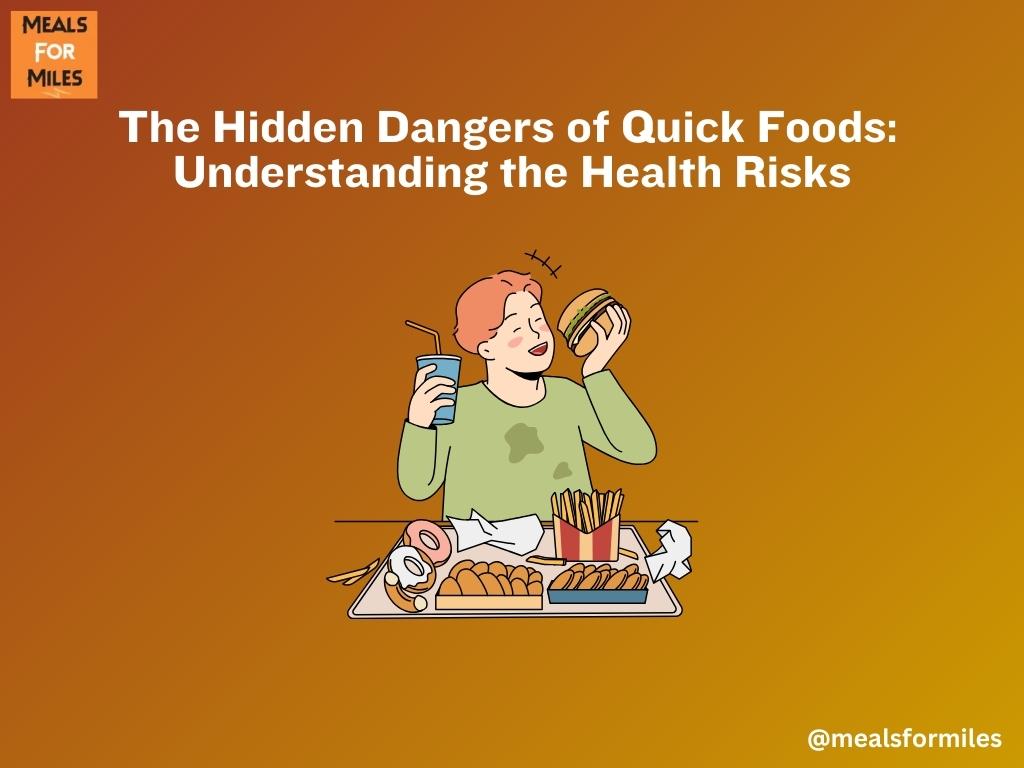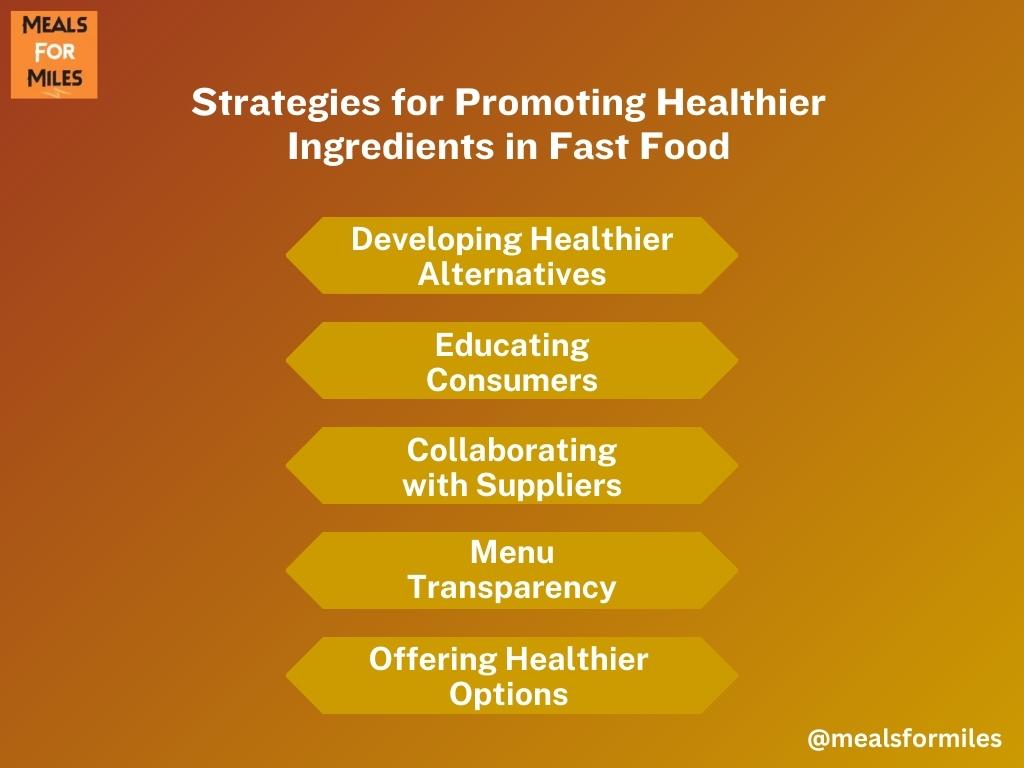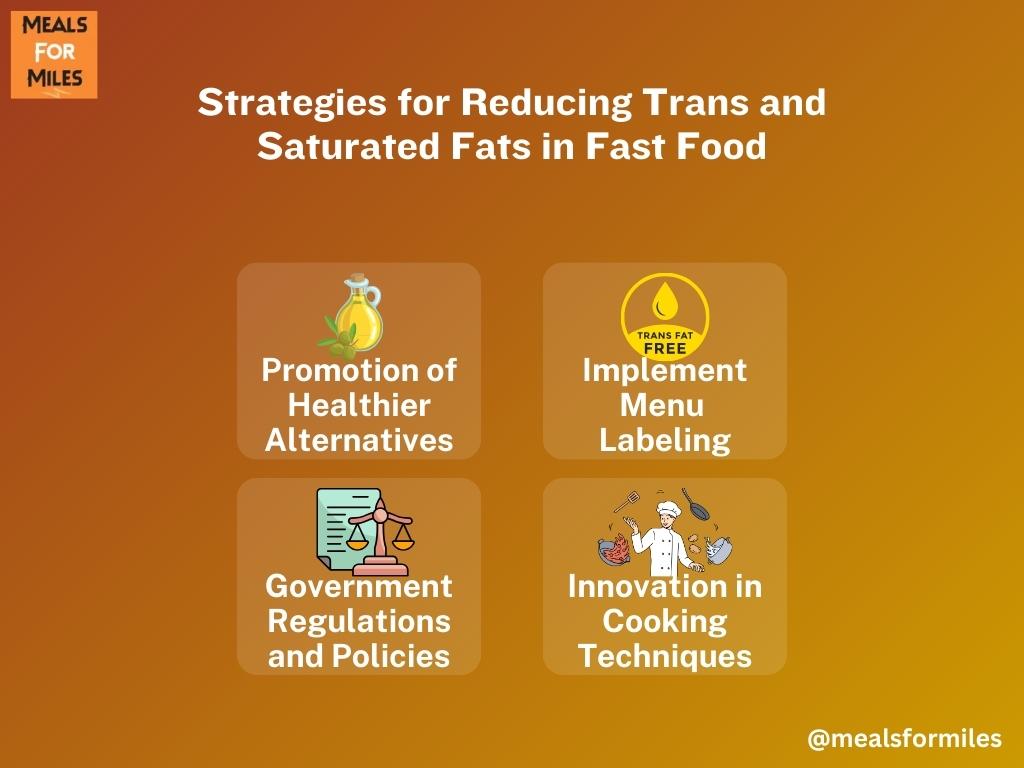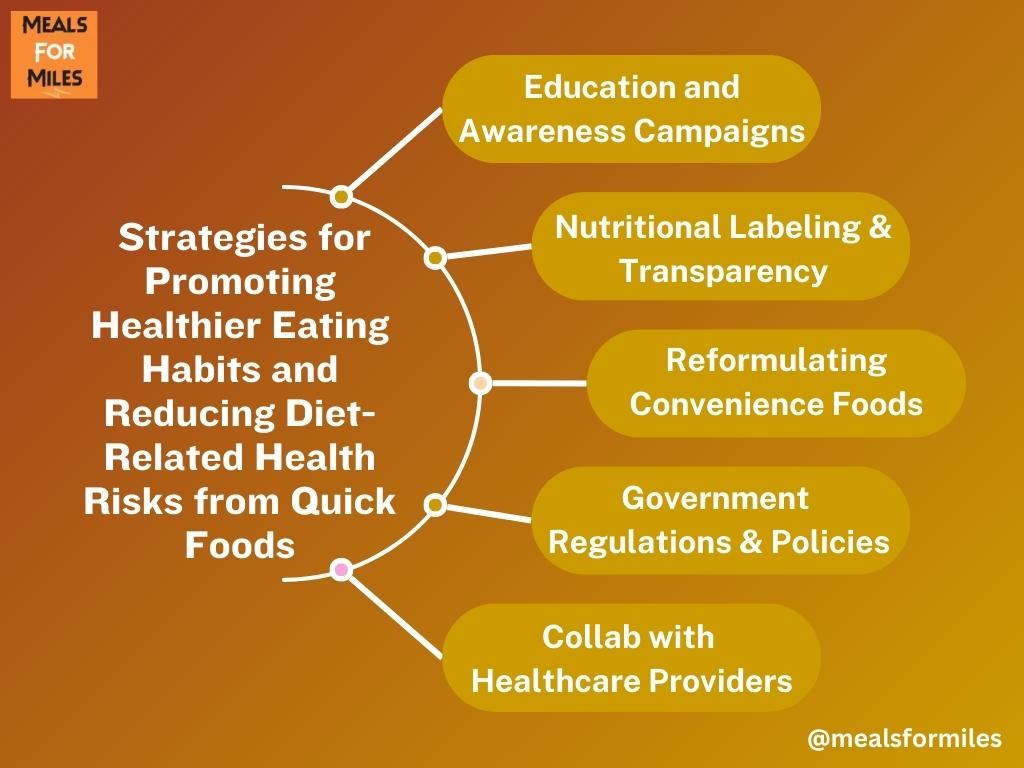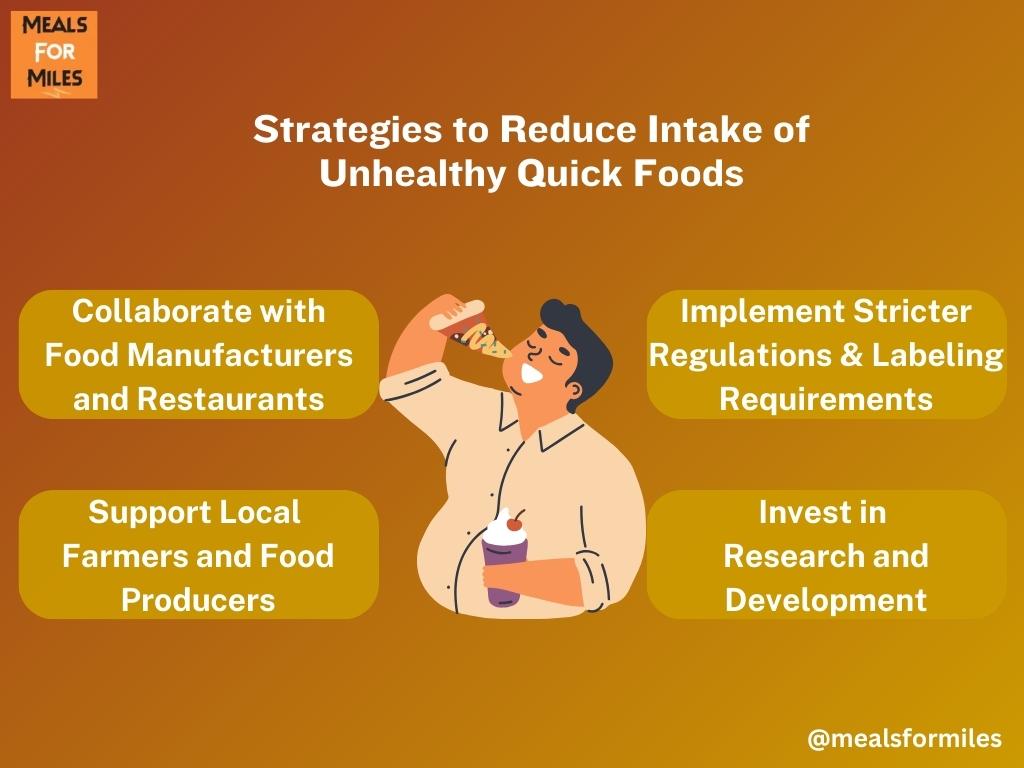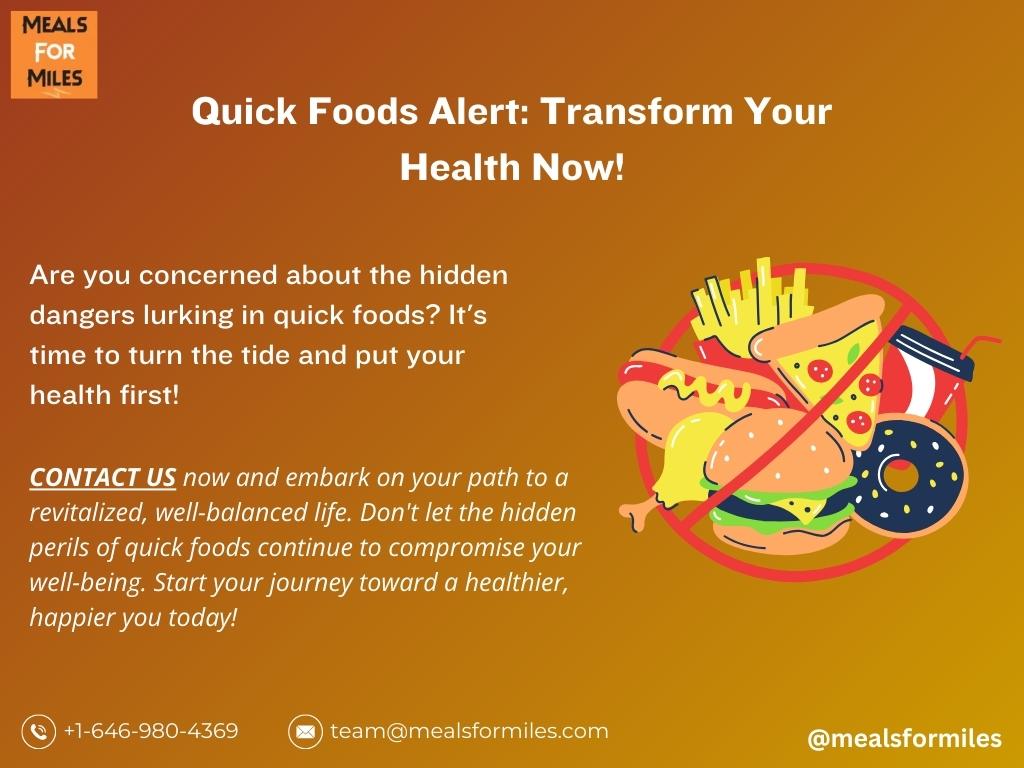Ready to take control of your health and minimize the hidden dangers of quick foods?
Our team of experts is here to guide you towards healthier alternatives and strategies for a balanced and nutritious lifestyle. From personalized meal plans to educational resources, we have everything you need to take charge of your well-being.
In today’s fast-paced world, fast food has become a popular choice for many individuals seeking a quick and convenient meal or snack. However, it is important to be aware of the hidden dangers that come with consuming these quick foods. Fast food is often loaded with unhealthy ingredients such as high sodium levels, trans fats, and possible carcinogens. This can lead to a variety of health issues including obesity, diabetes, and cardiovascular disease.
It is crucial for individuals to become familiar with nutritional labels and to identify any potentially dangerous substances in their favorite fast food items. In order to minimize health risks, it is essential to explore alternative sources of nutrients and to find a balance between indulging in cravings and opting for healthier options. By making small changes and being mindful of our food choices, we can take charge of our own health and well-being.
Table of Contents
- Introduction to the Hidden Dangers of Quick Foods
- Exploring the Unhealthy Ingredients in Processed Fast Food
- The High Sodium Levels in Fast Food
- Understanding Trans and Saturated Fats in Fast Food
- Exploring the Potential Carcinogens in Fast Food
- Obesity, Diabetes, and Cardiovascular Disease Linked to Poor Diet Quality from Quick Foods
- Exploring Alternative Sources of Nutrients to Minimize Health Risks from Quick Foods
- Strategies to Reduce Intake of Unhealthy Quick Foods
- Finding Balance with Healthy Alternatives to Quick Meals
- Final Thoughts
Introduction to the Hidden Dangers of Quick Foods
Quick foods have become a staple in today’s fast-paced society, offering convenience and instant gratification for those on the go. However, behind the allure of these convenient options lies a hidden danger that many are unaware of. Quick foods are often highly processed, loaded with artificial ingredients, preservatives, and excessive amounts of sodium and sugar. These unhealthy additives can lead to a myriad of health issues such as obesity, heart disease, diabetes, and even certain types of cancer. It is essential to raise awareness about the hidden dangers of quick foods and encourage individuals to make healthier choices for the sake of their well-being.
Exploring the Unhealthy Ingredients in Processed Fast Food
Processed fast food items are filled with unhealthy ingredients like preservatives, artificial colors and flavors, saturated fats, trans fats, high fructose corn syrup, and monosodium glutamate (MSG). These ingredients are used to enhance taste and prolong shelf life, but they have negative effects on our health. Some restaurants also use partially hydrogenated oils, which contain trans fat despite there being no safe amount recommended for consumption. It is crucial for individuals to read nutritional labels on packaged food to identify any harmful substances.
Here are the 10 Strategies for Promoting Healthier Ingredients in Fast Food:
- Developing Healthier Alternatives: Focusing on developing healthier alternatives to processed fast food items is essential. This could involve using natural ingredients, reducing saturated fats, eliminating artificial colors and flavors, and finding alternative sweeteners to replace high fructose corn syrup.
- Educating Consumers: Prioritizing consumer education about the unhealthy ingredients in processed fast food is vital. This could involve partnering with nutritionists and health professionals to provide information about the negative effects of these ingredients on health and raising awareness about the importance of reading nutritional labels.
- Collaborating with Suppliers: Fast food chains should work closely with their suppliers to ensure the use of healthier ingredients. This could involve sourcing organic ingredients, promoting the use of natural preservatives, and reducing the reliance on partially hydrogenated oils.
- Menu Transparency: Fast food restaurants could adopt a transparent approach by clearly indicating the ingredients used in their menu items. This could help consumers make informed choices and avoid items with unhealthy ingredients.
- Government Regulations: Advocating for stricter government regulations regarding the use of unhealthy ingredients in processed fast food is crucial. This could involve lobbying for mandatory labeling of trans fats and high fructose corn syrup, as well as encouraging limits on their usage.
- Promoting Home Cooking: Encouraging individuals to cook at home by providing easy-to-follow recipes and meal planning ideas is another approach. This would allow people to have control over the ingredients they use, reducing their consumption of processed fast food.
- Supporting Research and Development: Investing in research and development to find innovative ways to reduce or eliminate unhealthy ingredients in processed fast food is essential. This could involve exploring new cooking techniques, using natural food coloring alternatives, and developing healthier preservatives.
- Collaborating with Public Health Organizations: Fast food chains could partner with public health organizations to launch awareness campaigns and initiatives that highlight the negative effects of unhealthy ingredients. This collaboration could help spread the message to a wider audience and promote healthier eating habits.
- Offering Healthier Options: Fast food restaurants could expand their menu to include healthier options that are free from unhealthy ingredients. This would provide consumers with more choices and encourage them to make healthier food choices.
- Engaging in Product Reformulation: Lastly, actively engaging in product reformulation, gradually reducing the amount of unhealthy ingredients in processed fast food items, is essential. This could involve reformulating recipes, improving cooking methods, and replacing unhealthy ingredients with healthier alternatives.
The High Sodium Levels in Fast Food
Fast food is not only unhealthy due to additives, but it also contains high levels of sodium. This can be detrimental for those with chronic illnesses like hypertension or renal failure. A regular-sized burger alone contains over 500 mg of sodium, and adding condiments like ketchup can increase it even more. Having two burgers and fries could result in a sodium intake of 1120 mg, nearly half of what most adults should consume daily. Consuming diets with high salt content can increase the risk of conditions like stroke, coronary artery disease, type 2 diabetes, and certain types of cancer. Therefore, it is important to practice moderation when choosing fast food.
Here are the 10 Strategies for Reducing Sodium Levels in Fast Food:
- Reformulating Fast Food Recipes: Industry experts can work towards developing recipes that have lower sodium content without compromising on taste. This might involve substituting high-sodium ingredients with healthier alternatives or using different cooking techniques that enhance flavor without relying on excessive salt.
- Menu Labeling: Fast food chains can voluntarily provide clear and accurate information about the sodium content of their menu items. This will empower consumers to make informed choices and opt for lower-sodium options.
- Collaboration with Health Organizations: Fast food companies can partner with health organizations to raise awareness about the risks associated with high sodium intake. This can include educational campaigns, joint initiatives, or collaborations on research and development of healthier fast food options.
- Offering Low-Sodium Alternatives: Fast food establishments can introduce specific menu items that are low in sodium to cater to customers with dietary restrictions or those who are health-conscious. This can include sodium-reduced versions of popular items like burgers, fries, or sandwiches.
- Reformulating Condiments and Sauces: Many fast food condiments are high in sodium, such as ketchup, mayonnaise, or salad dressings. Industry experts can work on developing lower-sodium versions of these condiments or offer healthier alternatives like low-sodium soy sauce or vinaigrettes.
- Culinary Training and Education: Providing comprehensive training programs to fast food chefs and staff members can help them understand the impact of high sodium levels and learn techniques to reduce sodium in their cooking. This can include workshops, seminars, or online courses on sodium reduction and healthy cooking practices.
- Consumer Education: Fast food companies can invest in consumer education campaigns that highlight the importance of moderating sodium intake and making healthier choices. This can be done through social media campaigns, informative pamphlets, or collaborations with healthcare professionals to spread awareness about the dangers of excessive sodium consumption.
- Product Innovation: Industry experts can focus on developing new fast food products that are inherently lower in sodium. This can involve using alternative ingredients, exploring different flavor profiles, or incorporating more natural seasonings and herbs to enhance taste without relying on excessive sodium.
- Collaboration with Food Suppliers: Fast food chains can collaborate with food suppliers to ensure the ingredients they receive are lower in sodium. This can involve working closely with suppliers to set sodium reduction goals and actively seeking out suppliers that offer healthier alternatives.
- Government Regulations and Incentives: Industry experts can advocate for stricter government regulations on sodium levels in fast food products. Additionally, offering incentives or tax breaks to fast food chains that voluntarily reduce sodium content in their menu items can encourage widespread adoption of healthier practices.
Understanding Trans and Saturated Fats in Fast Food
Trans fats are commonly found in processed fast food items like pizza, chips, cookies, and fried chicken. These fats are created through a process called hydrogenation, which makes vegetable oil solid at room temperature. While this extends the shelf life of products, trans fats are known to increase bad cholesterol levels and decrease good cholesterol levels in the body, leading to negative health outcomes such as heart attack and stroke. Nutrition labels may round down to zero grams of trans fat for amounts below 0.5 grams per serving, so it is important to check the ingredient list for words like “partially hydrogenated” and avoid them if possible.
Here are the 7 Strategies for Reducing Trans and Saturated Fats in Fast Food:
- Promotion of Healthier Alternatives: Promoting the use of healthier alternatives to trans fats in fast food is crucial. This could involve the development and marketing of products that use healthier oils, such as olive oil or avocado oil, which do not contain trans fats. By offering these alternatives, fast food chains can cater to health-conscious consumers and provide a healthier option for those concerned about the negative health effects of trans fats.
- Menu Labeling: Implementing clear and easily understandable menu labeling that highlights the presence of trans fats in fast food items is essential. This could involve displaying a “trans fat warning” symbol next to items containing trans fats, alerting consumers to the potential health risks. Additionally, providing information on the amount of trans fats in each item, beyond just rounding down to zero grams, can help consumers make more informed choices.
- Collaboration with Food Manufacturers: Fast food chains can collaborate with food manufacturers to develop and promote healthier options for commonly consumed fast food items. By working together, they can find ways to reduce or eliminate trans fats from popular menu items like fries, chicken nuggets, and pastries. This collaboration can also extend to the development of healthier cooking methods that minimize the need for hydrogenated oils altogether.
- Education and Awareness Campaigns: Launching education and awareness campaigns to inform consumers about the dangers of trans fats and their presence in fast food is crucial. This could involve collaborating with health organizations and experts to develop informative materials, online resources, and social media campaigns to educate the public about the risks associated with consuming trans fats. By raising awareness, consumers can make more informed choices and demand healthier options from fast food chains.
- Government Regulations and Policies: Advocating for stricter government regulations and policies surrounding the use of trans fats in fast food is essential. This could involve lobbying for mandatory labeling of trans fats on food packaging, stricter limits on the amount of trans fats allowed in food products, and even advocating for a complete ban on the use of trans fats in fast food.
- Innovation in Cooking Techniques: Exploring innovative cooking techniques that eliminate the need for hydrogenated oils while still maintaining the taste and texture of fast food favorites is important. This could involve researching and implementing alternative methods such as air frying or using different types of oils that are more stable at high temperatures.
- Collaboration with Nutritionists and Dietitians: Fast food chains can partner with nutritionists and dietitians to develop healthier menu options and provide guidance to customers. This collaboration can involve creating specialized menu sections for those looking to avoid trans fats or offering personalized recommendations based on individual dietary needs. By working together, industry experts can ensure that fast food options are not only convenient but also align with consumers’ health goals.
Exploring the Potential Carcinogens in Fast Food
Recent studies have found that certain chemicals used in the preparation of fast food items may increase the risk of developing cancer. Chemicals such as PhIP, benzopyrene (BAP), acrylamide, heterocyclic amines (HCAs), and advanced glycation endproducts (AGEs) are suspected to be carcinogenic and are commonly found in grilled or charred meats that are cooked for too long at high temperatures.
Consuming large amounts of grilled meats is considered risky, and it is recommended to limit portion sizes and cook at moderate temperatures to reduce the formation of potential carcinogens and ensure safety, according to the American Institute for Cancer Research.
Here are the 10 Strategies for Minimizing Potential Carcinogens in Fast Food:
- Developing Alternative Cooking Methods: Invest in research and development to find alternative cooking methods that can reduce the formation of potential carcinogens in fast food. Explore new technologies such as infrared cooking or use steam-based cooking methods to minimize the production of harmful chemicals while maintaining taste and texture.
- Promoting Healthier Menu Options: Collaborate with nutritionists and health experts to develop and promote healthier menu options that are cooked in ways that minimize the formation of potential carcinogens. Introduce more plant-based options, reduce reliance on grilled or charred meats, and incorporate alternative protein sources with lower levels of these chemicals.
- Improving Ingredient Sourcing: Work closely with suppliers to ensure that meats and other ingredients used in fast food products are sourced from reputable sources that prioritize animal welfare and avoid the use of hormones and antibiotics. This can reduce the potential presence of harmful chemicals in the food and improve overall quality and safety.
- Implementing Stricter Cooking Guidelines: Establish and enforce stricter cooking guidelines to prevent overcooking or charring of meats, thereby reducing the formation of potential carcinogens. Provide training to employees on proper cooking techniques and invest in equipment for better temperature control and monitoring.
- Educating Consumers: Develop informative campaigns to raise awareness about the potential risks associated with consuming large amounts of grilled meats and charred foods. Provide information on portion sizes, cooking techniques, and highlight the availability of healthier options on fast food menus.
- Collaborating with Regulatory Bodies: Collaborate with regulatory bodies, such as the Food and Drug Administration (FDA), to establish industry-wide guidelines and standards for reducing the presence of potential carcinogens in fast food. Share best practices, conduct joint research studies, and participate in initiatives aimed at improving food safety and consumer health.
- Investing in Food Testing and Monitoring: Invest in regular food testing and monitoring to ensure compliance with safety standards and minimal levels of potential carcinogens in fast food products. Partner with independent laboratories or establish in-house testing facilities for regular chemical analysis.
- Providing Transparent Labeling: Improve transparency by providing clear and accurate labeling of fast food products, including information about cooking methods used and the potential presence of harmful chemicals. Enable consumers to make informed choices and encourage industry accountability.
- Supporting Further Research: Contribute to scientific research and studies aimed at better understanding the impact of potential carcinogens in fast food. Fund research initiatives or collaborate with academic institutions to find innovative solutions and enhance the overall safety of fast food products.
- Embracing Consumer Demand for Healthier Options: Acknowledge the growing consumer demand for healthier and safer fast food options. Advocate for a shift towards more sustainable and nutritious offerings, including organic ingredients, reduced use of processed meats, and increased inclusion of fresh produce on fast food menus.
Obesity, Diabetes, and Cardiovascular Disease Linked to Poor Diet Quality from Quick Foods
Eating a poor diet consisting of convenience foods, snacks, and sugary beverages is linked to obesity, diabetes, and cardiovascular disease. Research shows that people who consume more highly processed snacks tend to weigh more and have a higher BMI compared to those who eat whole grains, lean proteins, fruits, vegetables, nuts, and seeds.
Additionally, studies suggest that a diet high in ultra-processed foods increases the risk of mortality, coronary artery disease, stroke, digestive diseases, and certain types of cancer. It is important for individuals to take responsibility for their own health, understand the nutritional value of their food choices, and strike a balance between occasional indulgence and relying heavily on processed options. Overall wellness and longevity are at risk.
Here are the 8 Strategies for Promoting Healthier Eating Habits and Reducing Diet-Related Health Risks from Quick Foods:
- Education and Awareness Campaigns: Launch targeted campaigns to educate the public about the negative health effects of poor diet quality from quick foods. Utilize various channels such as social media, TV commercials, and community workshops to spread awareness and promote healthier food choices.
- Nutritional Labeling and Transparency: Encourage food manufacturers to provide clear and accurate nutritional information on their products, making it easier for consumers to make informed choices about their food purchases. Advocate for transparent labeling of added sugars, unhealthy fats, and other potentially harmful ingredients.
- Reformulating Convenience Foods: Collaborate with food companies to reformulate their convenience food products to make them healthier. This could involve reducing added sugars, using whole grains, increasing the inclusion of fruits, vegetables, nuts, and seeds, and minimizing the use of unhealthy fats and additives.
- Promoting Healthier Alternatives: Encourage the development and availability of healthier quick food options in the market. Partner with food companies to create and promote healthier versions of popular snacks and beverages that are lower in sugar, salt, and unhealthy fats.
- Government Regulations and Policies: Advocate for stricter regulations on the marketing and sale of unhealthy convenience foods, particularly when targeting children. This can include restrictions on advertising sugary beverages and snacks, as well as the implementation of taxes on high-sugar and high-fat products to discourage consumption.
- Collaborations with Healthcare Providers: Partner with healthcare professionals and organizations to integrate nutritional counseling and education into routine healthcare visits. Empower individuals to understand the impact of their diet on their health and provide them with personalized guidance on making healthier food choices.
- Workplace Wellness Programs: Encourage employers to implement workplace wellness programs that promote healthy eating habits among their employees. This can include providing access to nutritious food options in cafeterias and vending machines, organizing cooking classes, and offering incentives for healthy behaviors.
- Community Initiatives: Support community-based initiatives that promote access to fresh, affordable, and nutritious food options. Establish community gardens, organize farmers’ markets, and provide nutrition education in underserved areas to improve overall food quality and choices in communities.
By implementing these ideas, we can work towards reducing the prevalence of obesity, diabetes, and cardiovascular disease associated with poor diet quality from quick foods. It requires a collective effort from various stakeholders, including individuals, food manufacturers, healthcare providers, policymakers, and communities, to improve overall wellness and longevity.
Exploring Alternative Sources of Nutrients to Minimize Health Risks from Quick Foods
With the increasing popularity of quick foods, there is a growing concern about their potential health risks. To minimize these risks, it is important to look for alternative sources of nutrients. This can include adding more whole foods like fruits, vegetables, and lean proteins to our diets. It also means seeking out healthier options within the quick food industry, such as salads, grilled options, or low-sodium alternatives. By actively finding alternative sources of nutrients, we can make informed choices that prioritize our health without sacrificing convenience.
Here are the 6 Strategies for Enhancing Nutritional Value in Quick Foods and Promoting Healthier Choices:
- Collaborate with Quick Food Chains to Develop Healthier Menu Options: Partner with quick food chains to create and promote healthier menu options. This could involve incorporating more fruits, vegetables, and lean proteins into their offerings, as well as reducing sodium and unhealthy fats.
- Encourage Food Manufacturers to Fortify Quick Foods: Advocate for food manufacturers to fortify quick foods with essential nutrients. This could involve adding vitamins, minerals, and other beneficial compounds to these products, making them a more nutritious option for consumers.
- Educate Consumers About Whole Foods: Emphasize the importance of whole foods in minimizing health risks from quick foods and educate consumers about the benefits of fruits, vegetables, and lean proteins. This could be done through marketing campaigns, educational materials, or partnerships with nutritionists and dietitians.
- Develop Innovative Nutrient-Dense Products: Create innovative food products that are both quick and nutritious, such as pre-packaged meals or snacks made from whole food ingredients. By offering convenient options that are also nutrient-dense, you can provide consumers with a healthier alternative to traditional quick foods.
- Support Local and Sustainable Food Systems: Encourage the use of local and sustainable food systems within the quick food industry. This can involve sourcing ingredients from local farmers and promoting sustainable farming practices to offer fresher and healthier options to consumers.
- Invest in Research and Development for Alternative Nutrient Sources: Advocate for increased research and development efforts focused on alternative nutrient sources. This could involve exploring plant-based proteins, novel ingredients, or innovative food processing techniques that maximize nutrient retention. By investing in these areas, you can expand the range of options available to consumers and provide them with healthier alternatives to traditional quick foods.
Overall, by actively exploring alternative sources of nutrients within the quick food industry, we can address the health risks associated with these foods and provide consumers with convenient options that prioritize their well-being.
Strategies to Reduce Intake of Unhealthy Quick Foods
To reduce intake of unhealthy quick foods, choose healthier options when available such as vegetarian, vegan, gluten-free, organic, and paleo-friendly options. Read nutrition facts and choose brands with fewer chemical additives and lower calorie count. Prepare meals at home using fresh produce and stock up on nonperishable items to limit grocery store trips. Avoid drive-thrus and window shopping that may tempt you. Create a plan or schedule to stay on track with diet and exercise goals, monitor progress, and stick to a routine for long-term weight, shape, and fitness maintenance.
- Collaborate with Food Manufacturers and Restaurants: Collaborate with food manufacturers and restaurants to develop healthier versions of quick foods. This could involve reducing sodium, saturated fat, and sugar content, as well as increasing the inclusion of whole grains, fruits, and vegetables in these products.
- Implement Stricter Regulations and Labeling Requirements: Implement stricter regulations and labeling requirements for quick foods. This would ensure that consumers are better informed about the nutritional content of these items, making it easier for them to make healthier choices.
- Offer Incentives and Discounts for Healthier Options: Offer incentives and discounts for purchasing healthier quick food options. This could be done through loyalty programs, partnerships with health insurance companies, or government initiatives to encourage healthier eating habits.
- Provide Education and Awareness Campaigns: Provide education and awareness campaigns about the negative health effects of consuming unhealthy quick foods. This could be done through social media, television advertisements, and school programs to target different age groups and demographics.
- Collaborate with Schools and Workplaces: Collaborate with schools and workplaces to provide healthier quick food options in cafeterias and vending machines. This would make it easier for individuals to access nutritious meals and snacks throughout the day.
- Introduce Stricter Regulations on Marketing: Introduce stricter regulations on marketing unhealthy quick foods to children. This would limit the exposure and appeal of these products to younger audiences, promoting healthier eating habits from an early age.
- Support Local Farmers and Food Producers: Encourage and support local farmers and food producers to supply healthier ingredients for quick food options. This would promote the use of fresh, organic, and sustainably sourced ingredients in the production of these items.
- Invest in Research and Development: Invest in research and development to create innovative and tasty healthy quick food alternatives. This could involve utilizing alternative ingredients, such as plant-based proteins, to create products that are both nutritious and appealing to consumers.
- Partner with Fitness Centers and Gyms: Partner with fitness centers and gyms to promote healthy eating alongside exercise. This could involve offering nutrition workshops, meal planning assistance, or even providing healthy quick food options on-site.
- Implement Stricter Zoning Regulations: Implement stricter zoning regulations to limit the concentration of fast-food restaurants in certain areas. By reducing the availability and accessibility of unhealthy quick foods, individuals are more likely to opt for healthier alternatives.
Overall, a multi-faceted approach is necessary to reduce the intake of unhealthy quick foods. By offering healthier options, educating consumers, and creating a supportive environment, individuals can be empowered to make healthier choices and improve their overall well-being.
Finding Balance with Healthy Alternatives to Quick Meals
In today’s fast-paced world, it can be difficult to maintain a balanced diet. However, it is important to prioritize our health by choosing healthy alternatives to quick meals. Instead of relying on processed and convenient options, we should try to make homemade meals that are both nourishing and time-efficient.
This can be achieved by meal-prepping on weekends or using kitchen gadgets like slow cookers and instant pots. By incorporating more fruits, vegetables, whole grains, and lean proteins into our meals, we can ensure that we are getting the necessary nutrients and energy for a healthy lifestyle. Choosing healthy alternatives not only benefits our physical well-being but also improves mental clarity and overall satisfaction.
Here are the 10 Strategies for Encouraging Healthy Alternatives to Quick Meals:
- Meal-Prep Services: Provide meal-prep services that offer pre-packaged, balanced meals ready for heating and eating, catering to individuals or families with busy schedules.
- Healthy Fast-Food Chains: Fast-food chains can adapt to the growing demand for healthier options by offering items like grilled chicken, whole grain buns, and a wider range of vegetable-based sides.
- Healthy Vending Machines: Transform traditional vending machines by stocking them with fresh fruits, vegetable sticks, yogurt cups, and other nutritious options, providing convenient access to healthy meals on-the-go.
- Cooking Classes and Workshops: Offer cooking classes and workshops to teach individuals the skills and knowledge needed to prepare quick, healthy meals at home.
- Kitchen Gadget Innovation: Advance kitchen gadget technology to create appliances that simplify healthy cooking, such as smart appliances that suggest recipes based on scanned ingredients or appliances that speed up nutritious meal preparation.
- Corporate Wellness Programs: Employers can promote healthy eating habits by incorporating wellness programs that include healthy meal options in the workplace, partnering with local healthy food vendors, or offering on-site cooking classes for employees.
- Nutritional Labeling and Education: Enhance nutritional labeling on quick meals and develop educational campaigns to help consumers understand and interpret these labels, enabling them to make healthier choices.
- Mobile Apps and Meal-Planning Tools: Develop mobile apps and meal-planning tools that offer personalized meal suggestions, grocery lists, and nutritional tracking to help individuals meet their health goals.
- Collaboration Between Food Manufacturers and Nutritionists: Collaborate with nutritionists to create healthier versions of popular quick meals, focusing on reducing additives, increasing nutrient content, and improving the overall health profile of processed foods.
- Community Gardens and Urban Farming: Encourage community gardens and urban farming initiatives to empower individuals to grow their own fruits, vegetables, and herbs, promoting a healthier diet and fostering community bonds.
Overall, finding balance with healthy alternatives to quick meals requires a multi-faceted approach that involves education, innovation, and collaboration between different stakeholders in the food industry. By prioritizing our health and making conscious choices, we can create a world where healthy eating is convenient, accessible, and enjoyable.
Final Thoughts
It is crucial to be aware of the hidden dangers that come with consuming quick foods. These convenient and inexpensive options may seem appealing, but they often contain unhealthy ingredients such as high sodium levels, trans fats, and potential carcinogens. Consuming large amounts of fast food has been linked to obesity, diabetes, and cardiovascular disease due to poor diet quality. However, there are strategies that can be implemented to minimize the health risks associated with quick foods.
By exploring alternative sources of nutrients, individuals can make healthier choices when indulging in their favorite meals. Additionally, reducing the intake of unhealthy quick foods and finding a balance through healthy alternatives is essential for overall wellness and longevity. It is important to prioritize nutrition and educate oneself on the nutritional value behind food choices. By making informed decisions and opting for healthier options, individuals can take control of their health and well-being.
Don’t let convenience compromise your health any longer. Take action today and invest in your future by choosing healthier options.
Contact us now to learn more about our services and products that can help you minimize the hidden dangers of quick foods.

